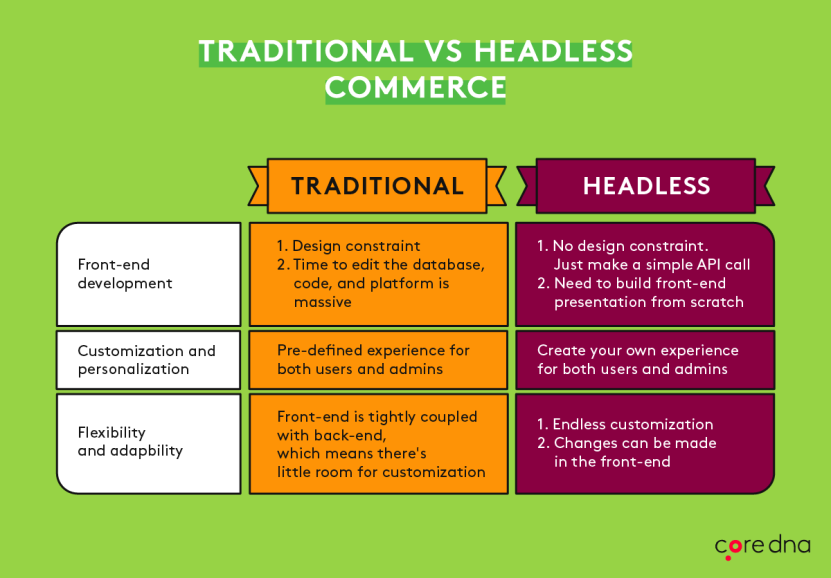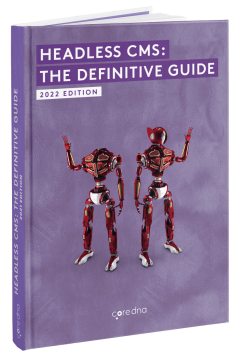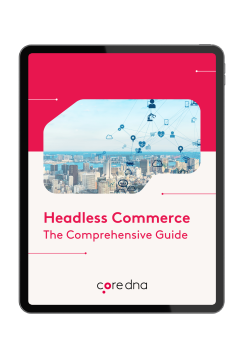Is Headless Architecture the Future of CMS and eCommerce?

The digital ecosystem is growing ever more complex thanks to the rise of IoT devices to progressive web apps.
As consumers increasingly expect engaging, cohesive digital interactions across the spectrum, legacy architecture simply is not dynamic enough to keep up. Fortunately, headless technology empowers brands with the flexibility and scalability to meet the moment.
This article will explain what headless architecture is and why it's the future of content managemement and eCommerce platforms.
On this page:
What is headless architecture?
A headless architecture is a decoupled approach to building digital applications. In a headless system, the front end (traditionally the UI meaning the looks of your website/application) is separated from the back end (the server side of the application), which dictates structure, defines logic, and stores data.
Unlike a traditional platform, headless systems give developers the ability to create different front ends for various formats (mobile, web, etc.) simultaneously.

Why use headless architecture?
Consumers are jumping on the IoT bandwagon, using voice-activated devices, VR/AR headsets, and more to shop online. With the decoupling of a headless approach, brands can deliver content across each device type without reinventing the wheel.
In short, any content or data stored in the backend can be formatted and shared to any device or channel. Headless environments allow developers to create a myriad of frontends to meet specific needs. For example, a retailer can develop a mobile app and share the same content on any other channel.
Headless platforms are ideal for businesses that need to deliver content to multiple devices or prefer to build their own unique front-end experiences. Developers and marketers can work together to easily create custom experiences for customers in any situation without worrying about compatibility issues.

Traditional vs. Headless architecture: the key differences
In traditional cms architecture, the frontend presentation layer is tightly coupled with the backend. In headless architecture, Application Programming Interfaces (APIs) connect the front- and backends, enabling communication between applications. The structures are drastically different, significantly impacting how businesses must choose to build their digital environments.
Understanding the differences between traditional and headless architecture can help determine what's best for your business. Let's compare and contrast some critical elements:
Installation
Traditional platforms are usually quicker and easier to deploy and install. Headless platforms, however, require finding and installing third-party front-end solutions or building one from scratch. Setting up can become time and resource intensive if you don't know exactly what approach you plan to take in a headless architecture.
Usability
Traditional platforms typically offer design templates that make systems user-friendly for non-developers. While this is easier for marketers and less technical personnel, developers must have knowledge and skills specific to the platform to make changes on the backend.
In headless architecture, developers configure specific APIs, such as REST APIs, to pass raw data, or content, from backend business logic services to the frontend presentation layers.
Flexibility
While traditional platforms grant simple content management and collaboration, they are usually limited to creating web content. In headless applications, raw content allows businesses to publish it anywhere through any framework, which is essential for omnichannel content efforts.
What is headless Microservices architecture?
A monolithic architecture provides a coupled system that allows users to easily manage and publish web content. Microservices architecture is an entire system built on a suite of services that use APIs to communicate and share data. This structure is decentralized, or "headless," with each microservice addressing a particular business goal. Microservice architectures are eclipsing monolithic platforms because they can better address rapidly changing business requirements.
Businesses that are adopting headless commerce architecture can respond to external changes much faster and adapt to new needs and expectations within days or weeks vs months. What happened during Covid and the sudden need for delivery and more reliance on connected objects is a practical example of the need of rapid change and adaptation.

Headless CMS: The Definitive Guide
Core dna Headless CMS guide gives you all the information about the different types of content management systems out there. We highlight the difference between headless and decoupled and give you the framework to choose what solution is best for your business.
Headless architecture vs. microservices
Microservices and headless are similar but have some fundamental differences. In a headless architecture, some parts of the system, aka the front-end and back-end, are decoupled. A microservices architecture takes the idea of decoupling even further, disconnecting everything. Some see this approach as more favorable because it makes replacing any microservice in the tech stack significantly easier without disrupting the entire platform. The microservices approach is particularly useful in larger, more complex organizations.
Headless architecture- a must-have in omnichannel eCommerce'
In the world of retail, personalization is now of the utmost importance. Every customer expects a seamless experience, whether shopping online or in a brick-and-mortar store. That means brands need to demonstrate they understand every customer's product preferences, shopping habits, and geographical considerations.
Headless architecture makes this possible by enabling brands to deliver tailored customer experiences online and offline, on any device, at any time. Using headless technologies, eCommerce stores can pass requests between the presentation and application layers through web services or API calls.
That means when a user clicks makes a purchase on their smartphone, the presentation layer of the headless eCommerce system sends an API call to the application layer to process the order. The application layer sends another API call to the application layer to show the customer their order status.
The same is true if a customer makes a purchase through an in-store kiosk, using a voice assistant, or anywhere else. In a headless commerce approach, the data passes seamlessly from the UI throughout the system, ensuring your inventory management, shipping, discounting, pricing, and returns solutions all update in real-time.
Whether pre- or post-purchase, customers are guaranteed a seamless, integrated experience. For this reason, headless commerce is absolutely critical for ensuring omnichannel eCommerce success.
Headless architecture is not limited to enterprises only
While enterprises with a more robust tech stack and IT teams are the biggest adopters of headless architecture, small and medium-sized businesses also benefit. Yes, the need for custom programming capabilities in a decoupled environment can be a significant investment. But in this age of rapid digitization, even smaller brands need modern technologies to build and manage global stores.
It no longer matters if you're B2B or B2C or a big or small organization; customers demand digital-first experiences. That means brands need to embrace innovation like never before. Many platform providers, including Core dna, offer flexible headless commerce solutions with all the features you need to compete in today's market.
What is an example of a headless application?
A good example of a headless application is a headless cms. In a traditional cms like WordPress, the software connects a website's frontend and backend. Traditional cms solutions integrate the templates users use to build their site with the backend administration and databases. The headless technology makes managing and editing web content easily without technical knowledge.
headless cms platforms decouple the frontend presentation layer with the back end. It allows users to choose how to present content instead of relying on a templating system. This architecture makes it easier to create highly tailored content to the individual's needs. With no default frontend system, a headless cms provides greater flexibility, letting you publish content anywhere through any framework, which is helpful for omnichannel content efforts.
What is a headless API?
An application programming interface (API) is a software intermediary that allows disparate applications or devices to connect and communicate. In a headless architecture, an API ensures data is passed between the services required to meet customer needs. For example, Core dna's digital experience platform includes hundreds of pre-built native integrations that connect to external systems.
One of the benefits of using headless architecture is that developers can then use APIs to deliver things like products, blog posts, or customer reviews to any screen or device. At the same time, front-end developers can work on presenting that content using any framework they desire.
What is a headless REST API?
A Web API (or Web Service) of the Representational State Transfer (REST) architecture is a REST API. A headless REST API uses REST architecture but is accessed and managed through code or a command-line interface rather than a graphical user interface (GUI). Headless REST APIs allow developers to create dynamic applications without building an entire user interface.
What is the difference between headless cms and REST API?
Headless cms platforms are back-end-only systems developers build from scratch. Rather than rely on a rigid, built-in UI, these platforms use a RESTful API or GraphQL API to make content accessible on any device.
While a headless cms can help you create content for different platforms making sure you get features like wysiwyg and content reuse is crucial for marketing teams to be able to manage content effectively.
FAQ
What does headless mean in web development?
The term "headless" describes web architectures that decouple the front and backends. Unlike a monolithic system, a headless architecture separates the data and content from the presentation layer where it is displayed. Many developers prefer the benefits of headless because it allows them to pick and choose their favorite third-party solutions and APIs to build a more flexible and scalable platform.
What is the opposite of a monolithic application?
A monolithic application is built as one cohesive platform comprised of a database and user interface. A headless platform is the opposite of a monolithic application because it separates the different layers.
What is an alternative to monolithic architecture?
A headless architecture is an excellent alternative to a monolithic solution. We are seeing more companies embracing headless eCommerce platforms because they are very flexible and allow businesses to adapt to new technologies or scale their operations quickly.
What is monolithic vs. tiered architecture?
Tiered architecture organizes software applications into three tiers: the presentation tier, the application tier, where data is processed, and the data tier, where the data is stored and managed.
What is modular vs. monolith architecture?
A monolithic architecture includes a tightly coupled structure and are not easily replaced.
A Modular architecture, sometimes called "minimal," is loosely coupled. That means its functions do not directly depend on each other and are easily replaceable.
What is the opposite of headless software?
A headless architecture is a decoupled approach to building digital applications where the front end is separated from the back end. This allows for the flexible integration of third-party applications and APIs
The opposite of this would be monolithic or traditional architecture. Monolithic architecture is self-contained and independent of other applications. The elements of traditional architecture are innate and not easily replaced.
What is a headless architecture design?
Headless design is another term for headless architecture in the development world. Headless design decouples the visual representation of content from the business logic required for their creation.

Headless Commerce: The Ultimate Guide
To stay competitive in today market, an omnichannel experience is mandatory and can only be achieved with a headless platform. With Core dna decoupled solution, you get the best of both worlds: A headless commerce with content preview and templates for a faster time to market.













